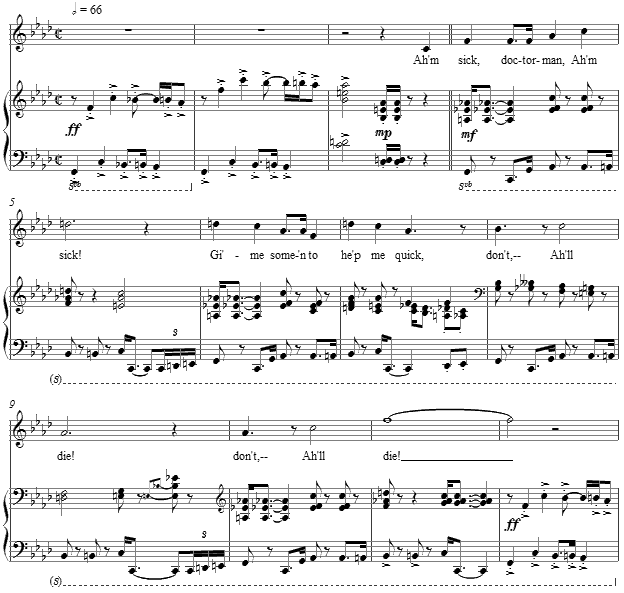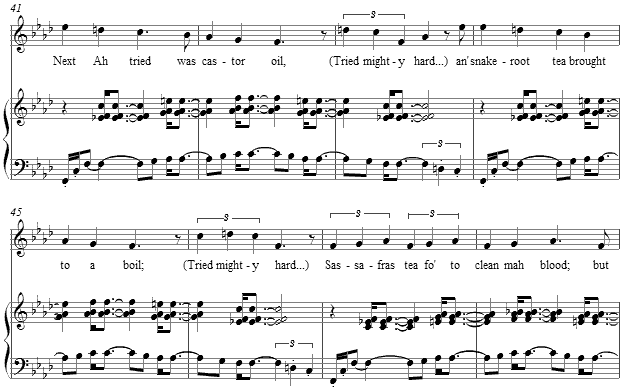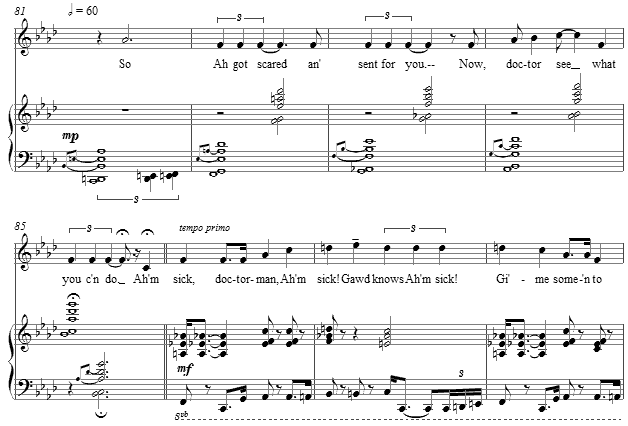Music and Texts of GARY BACHLUND
Vocal Music | Piano | Organ | Chamber Music | Orchestral | Articles and Commentary | Poems and Stories | Miscellany | FAQs
Calling the Doctor - (2008)
John Wesley Holloway
for medium or high voice and piano
Ah'm sick, doctor-man, Ah'm sick!
Gi' me some'n' to he'p me quick,
Don't,--Ah'll die!
Tried mighty hard fo' to cure mahse'f;
Tried all dem t'ings on de pantry she'f;
Couldn' fin' not'in' a-tall would do,
An' so Ah sent fo' you.
"Wha'd Ah take?" Well, le' me see:
Firs',--horhound drops an' catnip tea; [ 1 ]
Den rock candy soaked in rum,
An' a good sized chunk o' camphor gum;
Next Ah tried was castor oil,
An' snakeroot tea brought to a boil;
Sassafras tea fo' to clean mah blood;
But none o' dem t'ings didn' do no good.
Den when home remedies seem to shirk,
Dem pantry bottles was put to work:
Blue-mass, laud'num, liver pills, [ 2 ]
"Sixty-six, fo' fever an' chills,"
Ready Relief, an' A.B.C.,
An' half a bottle of X.Y.Z.
An' sev'al mo' Ah don't recall,
Dey nevah done no good at all.
Mah appetite begun to fail;
'Ah fo'ced some clabber, about a pail, [ 3 ]
Fo' mah ol' gran'ma always said
When yo' can't eat you're almost dead.
So Ah got scared an' sent for you.--
Now, doctor, see what you c'n do.
Ah'm sick, doctor-man. Gawd knows Ah'm sick!
Gi' me some'n' to he'p me quick,
Don't,--Ah'll die![ 6 pages, circa 3' 00" ]
A 19th century image of medicine
This comic text is found in The Book of American Negro Poetry, 1922. A short biography of Holloway as edited by J. W. Johnson is found therein:
"Born in Merriweather County, Ga., 1865. His father, who learned to read and write in slavery, became one of the first colored teachers in Georgia after the Civil War. Mr. Holloway was educated at Clark University, Atlanta, Ga., and at Fisk University, Nashville, Tenn. He was for a while a member of the Fisk Jubilee Singers. Has been a teacher and is now a preacher. He is the author of From the Desert, a volume of verse."
From a different edition, as Holloway's verse found its way into a number of collections, comes additional information about Holloway and a small editorial:
"Holloway is a disciple of Dunbar, although born before him -- and a worthy one, as may be judged from the musical lilt of 'Miss Melerlee' and
'The Corn Song' and from the humor of 'Calling the Doctor.' Holloway's best work is done in the dialect."
Holloway was more than poet, as (according to notes in an early edition of From the Desert, he was ordained a minister in the Congregational Church in 1900, served as pastor in several churches, including Guthrie, Oklahoma, Newark, New Jersey and Thebes, Georgia), before settling as pastor for the Congregational Church in Anniston, Alabama.
This panicked recitation of all the home-spun remedies which had further sickened this hypochondriac is all the more comic for its sheer exaggeration. For this a blue-note, two-measure phrase underpins the solidly F minor melody line with its inclusion of the raised sixth of the scale as third to the subdominant major. Over the syncopation of the accompaniment, the vocal line sings out a mostly square duple rhythm.
The list runs on with repetitions of the text, "tried mighty hard," to over-emphasize the excuse for such silly self-diagnosis and resultant over-medication.
The square, marching rhythm and phrases yield to a slower and freer section as the hypochondriac addresses the doctor with the startling and silly revelation that only after such a course of home-spun and folk medicines did he become "scared" enough to seek medical help. Panic again sets in as a reprise of the opening verse, now adding some additional text, driving forward to a close and last long cry, "Ah'll die!"
The score for Calling the Doctor is available as a free PDF download, though any major commercial performance or recording of the work is prohibited without prior arrangement with the composer. Click on the graphic below for this piano-vocal score.
NOTES
[ 1 ] More usually spelled "horehound," this is a downy perennial herbaceous plant, Marrubium vulgare, with small white flowers that contain a bitter juice formerly used as a cough medicine and flavoring, as well as used as flavoring in "horehound sticks," a candy which I also tasted in my youth.
[ 2 ] "Blue-mass" pills seem to have been among the popular folk remedies of the periods preceding and around the Civil War. It is mentioned as among the popular medication of that period in The Primes and their neighbors -- Ten tales of middle Georgia, Richard Malcolm Johnston, New York, D. Appleton and Company, 1891: "Even a slight cold alarmed him, and, while suffering from it, I wouldn't like to say what quantities of blue-mass, Brandreth's pills, hoarhound, and decoctions of Epsom salts and red pepper, went down his long neck."
Mark Twain mentions them as well while telling of an infant's misadventures, "It commenced by eating one dozen large blue-mass pills, box and all...." Sketches New and Old, Part 2 (circa 1865) and is mentioned as late as 1941 in Slave Narratives, Oklahoma, A Folk History of Slavery in the United States From Interviews with Former Slaves, in a verbatim narrative: "Negroes never was allowed to git sick, and when dey would look somewhat sick, de overseer would give dem some blue-mass pills and oil of some sort and make dem continue to work."
The second medication mentioned in this line of the poem, spelled correctly, is "laudanum," a popular remedy which was normally a tincture of opium, or any medicine of which opium was the main ingredient.
[ 3 ] Clabber [Dial.] for a thickly curdled sour milk; sometimes also called bonnyclabber. In earlier generations such sour milk was used in making biscuits and other baked products. As one elderly woman of Charleston said to me in asking about this, "I wouldn't drink no clabber."



